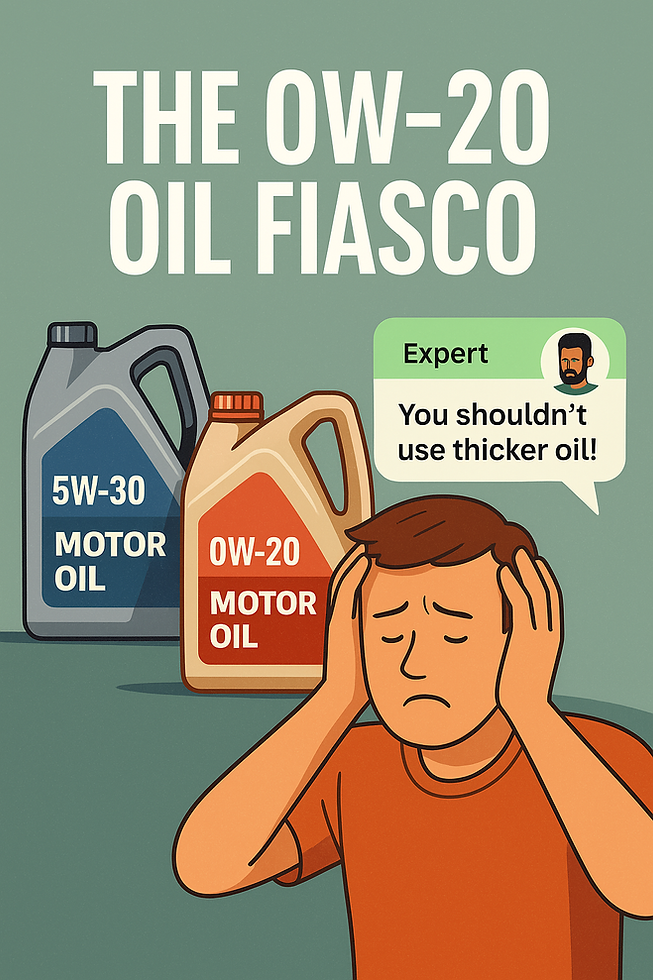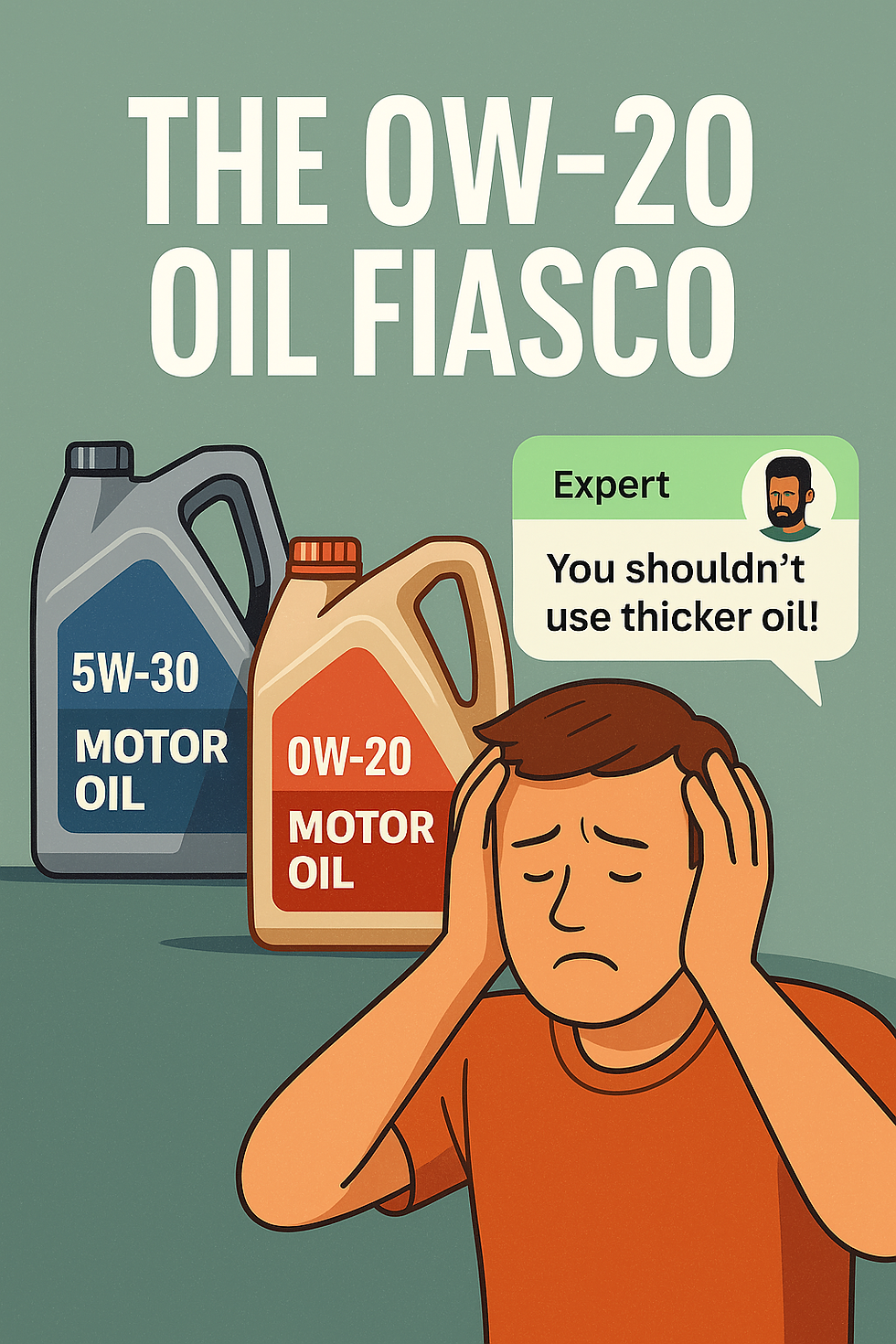
The 0W-20 Oil Fiasco: Why BS6 Cars Switched to Thinner Oil, Myths About Thick Oil, and Why Mid-SAPS is Best for Tuned Engines | ICD TUNING & The Madras Mechanic
- The Madras Mechanic

- Aug 13
- 5 min read
The 0W-20 switch in BS6 cars explained. Myths, facts, and what works in the real world.

The Internet & WhatsApp Panic
Ever noticed how the most useless WhatsApp car groups have the most confident advice?
They can diagnose a noise from a 5-second voice note and have already decided which oil will “save” or “kill” your engine.
When BS6 cars started coming with 0W-20, these groups went into overdrive:
> “Engines have tiny oil pipes now! Thick oil can’t reach bearings!”
“0W-20 is the only safe oil for these engines!”
…Said mostly by people who’ve never had an oil pump in their hand, never done a rebuild, and probably think HTHS is a DJ in Goa.
Why OEMs Switched to 0W-20
There are three big reasons:
1. Fuel Economy & CO₂ Targets
Thinner oil reduces friction losses, especially during warm-up. That means a measurable (small, but measurable) gain in fuel economy, which helps OEMs meet government CO₂ targets.
2. After-Treatment Life (BS6 Requirement)
BS6 norms brought DPFs (diesel particulate filters) and GPFs/OPFs (petrol particulate filters) into the mainstream.
Low-viscosity, low-SAPS oils keep ash and phosphorus low, protecting these filters and catalytic converters.
3. OEM Approvals Built Around It
Approvals like VW 508.00/509.00 or BMW LL-17 FE+ were created specifically for 0W-20 with low HTHS (2.6–2.9 mPa·s) to meet these fuel economy and after-treatment targets.
ICD TUNING’s Reality Check
We’ve serviced and tuned hundreds of BS6 cars, petrol and diesel in Chennai’s heat.
We’ve run 5W-30 and 5W-40 on tuned BS6 cars making double stock power, with DPF/OPF removed for track use, and on daily drivers. Not a single case of oil starvation or bearing damage because of viscosity.
The only thing that changes?
On stock BS6 cars with DPF/OPF, the filter takes a few extra minutes to reach regen temperature with thicker oil. That’s it.
A Quick Oil Spec 101
Forget just “thick” or “thin” here’s what matters:
Viscosity grade (e.g., 0W-20, 5W-30, 5W-40) = how thick the oil is cold vs. hot.
HTHS (High Temperature High Shear) = how well the oil maintains film strength under load.
SAPS (Sulphated Ash, Phosphorus, Sulphur) = how much the oil can poison after-treatment parts.
The Approval Layers:
1. API/ILSAC – global basic spec for wear, deposits, and fuel economy.
2. ACEA – European standard, tighter on SAPS for DPF/GPF (e.g., C3, C5, C6).
3. OEM Approvals – strictest. Example:
VW 504/507 = 5W-30, HTHS ≥3.5, mid-SAPS (DPF/GPF safe).
VW 508/509 = 0W-20, HTHS ~2.6–2.9, ultra-low-SAPS (max FE).
BMW LL-01/LL-04 (5W-30/40) vs. LL-17 FE+ (0W-20).
Myth-Busting: “Thin Galleries”
Modern oil pumps are pressure-regulated. Bearings have clearances that work with a range of viscosities.
If thicker oil “couldn’t reach critical regions,” every tuned engine running 5W-40 would be dead in a week.
ICD TUNING data point: Our in-house tuned BS6 VAG petrol making 2x stock torque, running 5W-40 for over 50-60k km no scoring, no starvation, perfect compression.
The OPF/DPF Warm-Up Angle
Yes, thinner oil warms up slightly faster, which can help filters reach operating temp sooner.
But in reality, exhaust temp management is a calibration job, not an oil job. ECU can:
Post-inject fuel (diesel)
Retard spark (petrol)
Increase idle/load
These strategies raise EGTs far more than shaving 10 seconds off oil warm-up.
Why We Favour Mid-SAPS for Tuned Builds
At ICD TUNING, we stick to mid-SAPS oils (like ACEA C3/C6 5W-30) for tuned modern cars and here’s why:
Better Wear Protection
Older-style components like flat-tappet cams or aggressive cam profiles benefit from higher phosphorus/ZDDP levels. Low-SAPS oils meet wear limits; mid-SAPS often exceed them, giving a bigger safety margin under heavy load.
Cleaner Direct-Injection Engines
DI engines don’t have fuel washing the intake valves. Mid-SAPS formulations help reduce deposit formation compared to high-SAPS, while still protecting after-treatment systems.
Balanced for After-Treatment & Performance
Specs like ACEA C6 are mid-SAPS, after-treatment safe, yet built for extended drains, high load, and good fuel economy, perfect for tuned BS6 cars that still run their DPF/GPF.
This balance is why, even on modern engines, mid-SAPS doesn’t mean “old tech” it means using an oil designed for real-world high-load use without sacrificing emissions hardware.
When Thicker Oil Makes Sense
If your car is:
Tuned / high load (track, towing, hard highway runs)
Running without DPF/OPF (track/off-road)
In a hot climate (like India, summer garage temps 40°C+)
…then a 5W-30 or 5W-40 with the correct approval can give more film strength and better high-load protection.
How to Choose the Right Thicker Oil
VW/Audi – VW 504/507 5W-30 (mid-SAPS, DPF/GPF-safe).
BMW – LL-04 5W-30/40 for heavy-duty; LL-17 FE+ for 0W-20 economy spec.
Toyota/Maruti – API SP / ACEA C3 5W-30 from a reputable brand.
Hyundai/Kia – ACEA C3 5W-30 or API SP 5W-30 with low/mid-SAPS; for tuned petrol turbos, a full-SAPS ACEA A3/B4 5W-40 (off-road/track use) can be considered.
Renault/Nissan – RN17 5W-30 (mid-SAPS, DPF-safe) for BS6; RN0710 5W-40 for older/tuned petrol & diesel without after-treatment.
Mercedes-Benz – MB 229.52 (low-SAPS, 5W-30) for BS6 DPF-equipped models; MB 229.5 (full-SAPS 5W-40) for high-performance petrol and non-DPF diesels.
Ford – WSS-M2C913-D or WSS-M2C952-A1 5W-30 for BS6; WSS-M2C931-C 5W-40 for tuned/off-road use.
Honda – API SP / ILSAC GF-6 5W-30 (low/mid-SAPS); for older petrol performance builds, ACEA A3/B4 5W-40.
Skoda – Same as VW: VW 504/507 5W-30 mid-SAPS, or VW 502/505 5W-40 for older/tuned.
Golden rule: If the oil has the right approval, it will be safe for the engine. The “20” or “30” is secondary to meeting that spec.
Protecting Emissions Parts on Thicker Oil
If you run thicker oil but still have a DPF/OPF:
1. Drive gently for the first minute after cold start, let coolant/oil begin to warm.
2. Add load after warm-up, a quick highway burst or spirited run helps raise EGT for regen.
3. Avoid constant short trips, incomplete regens kill filters.
4. Stick to low-SAPS oils, keeps ash build-up slow.
The Madras Mechanic’s Final Thought
> The problem isn’t 0W-20. The problem is blind fear, fed by WhatsApp “experts” who’ve never seen the inside of an engine.
At ICD TUNING, we pick oil based on how the car is driven, what hardware it runs, and what approval the oil carries, not what some group admin says.
If your car is stock, still has its DPF/OPF, and you care about warranty, stick to 0W-20 with the correct approval.
If your car is tuned, high-load, or runs in extreme heat, a thicker mid-SAPS approved oil can give you more protection without hurting the engine.
Engines die from bad oil quality, wrong specs, and neglect, not from going from a “20” to a “30” on the bottle.
Gettuned to what's real! Stay informed.
Yours truly,
The Madras Mechanic
Your BS Filter for Car Myths.



The service centre fills 0W20 Mineral oil in my Elite I20 1.2 G4LA 2020(BS6). I have told them many times that the manual says 5W30 ACEA A5/B5 oil grade but they don't have it in stock and say it's alright with this oil but after driving some 3-4k kms I can feel a bit of sluggishness in idling after a highway run.
Mine is a petrol hycross GX and the company recommended 0w16. Can I change it to 5w30? This car is fleet used